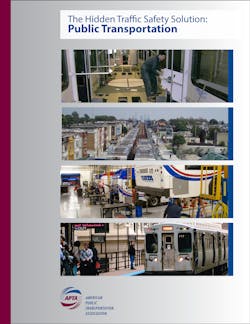Report: The Hidden Traffi c Safety Solution: Public Transportation
This report investigates the impacts that public transportation has on traffic safety (crash risk), and the potential for transit-supportive policies (policies that improve and encourage public transit travel, and create more transit-oriented communities) to help achieve traffic safety goals.
Public transportation is overall a very safe form of travel. Its passengers have less than a tenth the per-mile crash rates as automobile occupants, and transit-oriented communities have less than a fifth the total (pedestrian, cyclist, automobile and transit passenger) per capita traffic fatality rates as in automobile-dependent communities.
Traffic casualty rates tend to decline in a community as transit ridership increases. In fact, cities where residents average more than 50 annual transit trips have about half the average traffic fatality rates as cities where residents average fewer than 20 annual transit trips, making public transportation a cost-effective traffic safety strategy.
